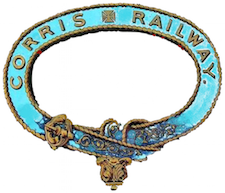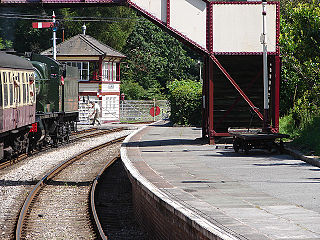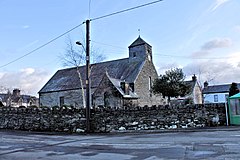
The Corris Railway is a narrow gauge preserved railway based in Corris on the border between Merionethshire and Montgomeryshire in Mid-Wales.

The Narrow Gauge Railway Museum is a purpose-built museum dedicated to narrow-gauge railways situated at the Tywyn Wharf station of the Talyllyn Railway in Tywyn, Gwynedd, Wales.

Merionethshire or Merioneth is one of thirteen historic counties of Wales, a vice county and a former administrative county.

Machynlleth is a market town, community and electoral ward in Powys, Wales and within the historic boundaries of Montgomeryshire. It is in the Dyfi Valley at the intersection of the A487 and the A489 roads. At the 2001 Census it had a population of 2,147, rising to 2,235 in 2011. It is sometimes referred to colloquially as Mach.

The parish church of St Peter ad Vincula in the village of Pennal in Gwynedd, north-west Wales, is notable as the site of the last senate meeting held by the Welsh prince, Owain Glyndŵr. It was founded in the 6th century, supposedly by St Tannwg and St Eithrias, and is the only church in Wales with this dedication. It is now part of the benefice of Bro Ystumanner in the diocese of Bangor.

Aberllefenni quarry is the collective name of three slate quarries, Foel Grochan, Hen Gloddfa and Ceunant Ddu, located in Cwm Hengae, just to the west of Aberllefenni, Gwynedd, North Wales. It was the longest continually operated slate mine in the world until its closure in 2003. Foel Grochan is the quarry on the north side of the valley, facing Ceunant Ddu and Hen Gloddfa on the south; all three were worked as a single concern throughout their history. Rock was mainly extracted underground, though all three quarries had open pits as well.

Esgairgeiliog is a village in Powys, Wales, UK. It is situated at the junction of the Afon Glesyrch's and Afon Dulas' valleys.

Sarn Helen refers to several stretches of Roman road in Wales. The 160-mile (260 km) route, which follows a meandering course through central Wales, connects Aberconwy in the north with Carmarthen in the west. Despite its length, academic debate continues as to the precise course of the Roman road. Many sections are now used by the modern road network while other parts are still traceable. However, there are sizeable stretches that have been lost and are unidentifiable.

Glyndyfrdwy, or sometimes Glyn Dyfrdwy, is a village in the modern county of Denbighshire, Wales. It is situated on the A5 road halfway between Corwen and Llangollen in the Dee Valley.

Corris Uchaf is a village lying in the south of the Snowdonia National Park in Gwynedd, Wales. The slate quarries that surround Corris Uchaf are its most prominent feature.

Braichgoch slate mine was a large slate mine located in Corris Uchaf, north Wales. It was worked continuously from 1787 until closure in 1970, apart from a hiatus in the 1900s. Most of the surface workings of the quarry were removed as part of a road widening and landscaping scheme in 1983.

The Hendre-Ddu Tramway was a 1 ft 11 in narrow gauge industrial railway built in 1874 in Mid-Wales to connect the Hendre-Ddu slate quarry to Aberangell station on the Mawddwy Railway. It consisted of a main line 3+1⁄2 miles (5.6 km) long and several branch lines and spurs serving other quarries, local farms and the timber industry.
The Mawddwy Railway was a rural line in the Dyfi Valley in mid-Wales that connected Dinas Mawddwy with a junction at Cemmaes Road railway station on the Newtown and Machynlleth Railway section of the Cambrian Railways.
Narrow-gauge railways were used extensively in the slate industry of Great Britain, especially in Wales. Many quarries had internal tramways, some using many dozens of miles of track. Others had private lines that stretched from the quarry to transhipment points on local railways, rivers, roads or coastal ports.

Morben is a hamlet in northern Powys, Wales. Part of the historic county of Montgomeryshire from 1536 to 1974, it lies on the Afon Dyfi and was once the home of a number of riverside quays, including Cei Ward and Y Bwtri. The site of Cei Ward lies alongside the A487 opposite Plas Llugwy, where the road, railway and river run close together. Y Bwtri lay on the bend of the river opposite Pennal and was the site of a shipyard.

The Afon Dulas, or North Dulas, is a river forming the border between Merionethshire/Gwynedd and Montgomeryshire/Powys in Wales. Another river called Afon Dulas joins the Dyfi from the south, upstream of its confluence with the North Dulas: locally this is referred to as the South Dulas.

The Ratgoed Tramway was a 2 ft 3 in gauge horse-worked tramway that connected the remote Ratgoed Quarry with the Corris Railway at Aberllefenni. It was 1.75 miles (2.82 km) long.

Cymerau quarry was a slate quarry served by the Ratgoed Tramway, a horse-worked section of the Corris Railway. It is located about half a mile north of Aberllefenni in Merioneth, North Wales, on the eastern side of the isolated Cwm Ceiswyn. It worked the Narrow Vein, the highest-quality slate vein in the Abercorris Group.

The Cwm Ebol quarry was a slate quarry about 1 mile (1.6 km) north west of the village of Pennal in Mid Wales. It operated from about 1860 to about 1906. It was the last Welsh slate quarry connected only to a trans-shipment point instead of directly to a railway.

Baguley 774 is one of the earliest surviving narrow-gauge internal combustion locomotives. It was built in 1919 for the Timber Supply Department of the Board of Trade. After a varied career, it was preserved at the Narrow Gauge Railway Museum in Tywyn.




















